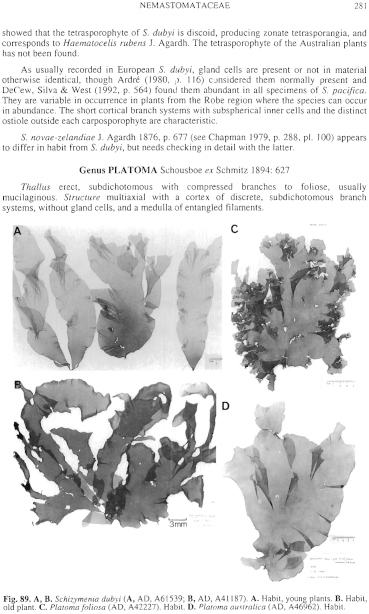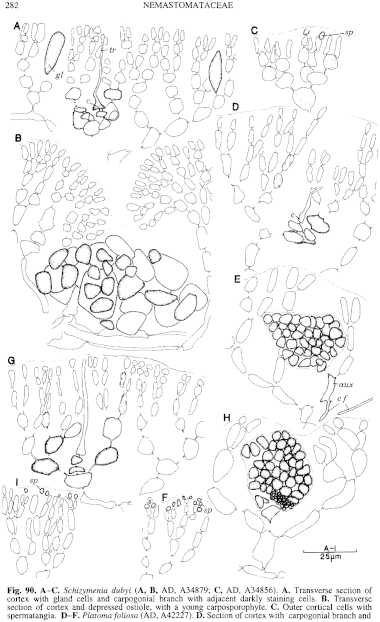|
|
|
|
|
|||||||||||
|
Electronic Flora of South Australia Species Fact Sheet
Phylum Rhodophyta – Class Florideophyceae – Order Gigartinales – Family Nemastomataceae
Thallus (Fig. 89C) medium to dark red-brown, slightly mucilaginous, (10–) 20–65 cm high and across, foliose and simple or with several large lobes, and with small marginal lobes 1–3 cm across giving an irregular outline, 300–600 µm thick, usually with "deltaic" markings for 5–10 cm above the base, broadening markedly from a short stipe 1–4 mm long. Holdfast discoid, 2–5 mm across; epilithic. Structure of a cortex (80–) 120–160 µm thick, of discrete branch systems 8–12 cells long, subdichotomous every 1–2 cells, inner cells ovoid to elongate, (4–) 8–12 µm in diameter and L/D 1.5–2 (–3), outer cortex of relatively straight filaments 3–4 µm in diameter, cells L/D 1.5–3 (–5); gland cells absent. Medulla of relatively lax longitudinal and entangled filaments 4–6 µm in diameter. Rhodoplasts several per cell, discoid to elongate.
Reproduction: Sexual thalli monoecious. Carpogonial branches (Fig. 90D) 3-celled, borne on an inner cortical (supporting) cell with adjacent cells often darkly staining, and with the cortical filaments borne on the supporting cell shorter than adjacent cortical filaments (Fig. 90D); a sterile cell on the supporting cell or first cell of the carpogonial branch. Auxiliary cells in a similar position to supporting cells, bearing shorter cortical filaments, producing the carposporophyte directly following union with a connecting filament. Carposporophyte (Fig. 90E) lying between cortical filaments, ovoid to conical, 60–100 µm across, with all cells becoming ovoid to angular carposporangia 8–10 µm across. Pore above carposporophyte absent to slight, due only to separation of cortical filaments by the carposporophyte or the slight depression due to shorter cortical filaments from the auxiliary cell. Spermatangia (Fig. 90F) cut off outermost cortical cells, ovoid, 1.5–2.5 µm in diameter.
Tetrasporangia unknown.
Type from Nora Creina, S. Aust., 5–6 m deep (R. Lewis & Kraft, 13.v.1972); holotype in AD, A42227; isotype in MELU, A40381.
Selected specimens: Nuyts Reef, S. Aust., 9–10 m deep (Shepherd, 26.iii.1980; AD, A52310). Elliston, S. Aust., drift (Womersley, 27.ii.1959; AD, A22168). Topgallant I., Investigator Group, S. Aust., 27 m deep (Turner, 29.iii.1982; AD, A53063). Pelorus I., S of Kangaroo I., S. Aust., 10–30 m deep (Branden, 19.vi.1991; AD, A61389). Granite I., Victor Harbor, S. Aust., 4 m deep inside breakwater (Collings, 12.viii.1991; AD, A61475). Robe, S. Aust., drift (Womersley, 5.viii.1961; AD, A25490). Port MacDonnell, S. Aust., drift (Womersley, 17.v.1983; AD, A54515). Point Lonsdale, Vic., drift (G., L. & J. Kraft, 26.iv.1992; MELU, 40382). The Nobbies, Phillip I., Vic., 15 m deep (Huisman, 8.vi.1980; MELU, 40350). Currie R., Tas. (Perrin 457 & Lucas, April 1934; AD, A49744).
Distribution: Nuyts Reef, S. Aust., to Phillip I., Vic., and Currie R., N. Tasmania.
Taxonomic notes: Platoma foliosa differs from the superficially similar Schizymenia dubyi in habit, having an irregular margin usually with numerous small lobes, a broader cortex with branch systems with longer cells (especially in the outer cortex), only slight pores above the shorter filaments on the auxiliary cells, and in having the carposporophyte lying within the cortex. The medulla of P. foliosa is also laxer and the deltaic markings on the lower thallus are more prominent.
The several other foliose species of Platoma differ (on limited information available) from P. foliosa in branching and details of the cortical branch systems (see Norris & Bucher 1977, p. 160). P. foliosa appears to be closest to P. incrassata Schousboe (Bornet 1892, p. 343: De Toni 1905, p. 1646) in the Mediterranean, but does not have the thickened margins of the latter.
References:
BORNET, E. (1892). Les Algues de P.-K.-A. Schousboe. Mem. Soc. Nat. Sci. Nat. et Math., Cherbourg, 28, 165–376, Plates
DE TONI, G.B. (1905). Sylloge Algarum omnium hucusque Cognitarum. Vol. 4. Florideae. Sect. 4, pp. 1523–1973. (Padua.)
NORRIS, J.N. & BUCHER, K.E. (1977). The genus Platoma (Gigartinales, Rhodophyta) with a description of P. abbottiana sp. nov. J. Phycol. 13, 155–162.
The Marine Benthic Flora of Southern Australia Part IIIA complete list of references.
Publication:
Womersley, H.B.S. (14 January, 1994)
The Marine Benthic Flora of Southern Australia
Rhodophyta. Part IIIA, Bangiophyceae and Florideophyceae (to Gigartinales)
Reproduced with permission from The Marine Benthic Flora of Southern Australia Part IIIA 1994, by H.B.S. Womersley. Australian Biological Resources Study, Canberra. Copyright Commonwealth of Australia.
Illustrations in Womersley Part IIIA, 1994: FIGS 89C, 90 D–F.

Figure 89 enlarge
Fig. 89. A, B. Schizymenia dubyi (A, AD, A61539; B, AD, A41187). A. Habit, young plants. B. Habit, old plant. C. Platoma foliosa (AD, A42227). Habit. D. Platoma australica (AD, A46962). Habit.

Figure 90 enlarge
Fig. 90. A–C. Schizymenia dubyi (A, B, AD, A34879; C, AD, A34856). A. Transverse section of cortex with gland cells and carpogonial branch with adjacent darkly staining cells. B. Transverse section of cortex and depressed ostiole, with a young carposporophyte. C. Outer cortical cells with spermatangia. D–F. Platoma foliosa (AD, A42227). D. Section of cortex with carpogonial branch and adjacent darkly staining cells. E. Cortex with auxiliary cell and connecting filament, and carposporophyte. F. Outer cortex with spermatangia. G–I. Platoma australica (G, AD, A46962; H, I, AD, A45120). G. Transverse section of cortex with a carpogonial branch and adjacent darkly staining cells (two cells with rhodoplasts). H. Carposporophyte. I. Outer cortex with spermatangia.

|
Email Contact: State Herbarium of South Australia |

|